One of the most fascinating trends unfolding in our future involves the world’s oldest profession.
No – not that one. Agriculture!
Imagine skyscrapers full of plants. That’s what begins to happen when the marriage of radical concepts, technology, and a pressing need for innovative thinking collide together to provide for a very BIG trend.
One that leads to a potential future in which we are no longer restricted to farming outdoors – in the future, we will be doing much more of it indoors as well. As a global society, we need to do this – because as the world’s population grows to 8 billion, we need BIG, bold solutions to come up with new ways of growing global food production. And what has happened is that our early experiments with the concept of growing indoors are about to enter the industrial scale, as we see the arrival of trends that bring together technology, advanced science, disruptive ideas, and new concepts – bringing into reality a new industry that promises to provide fast innovation that solves one of the biggest challenges of our time!
Vertical farming at scale.
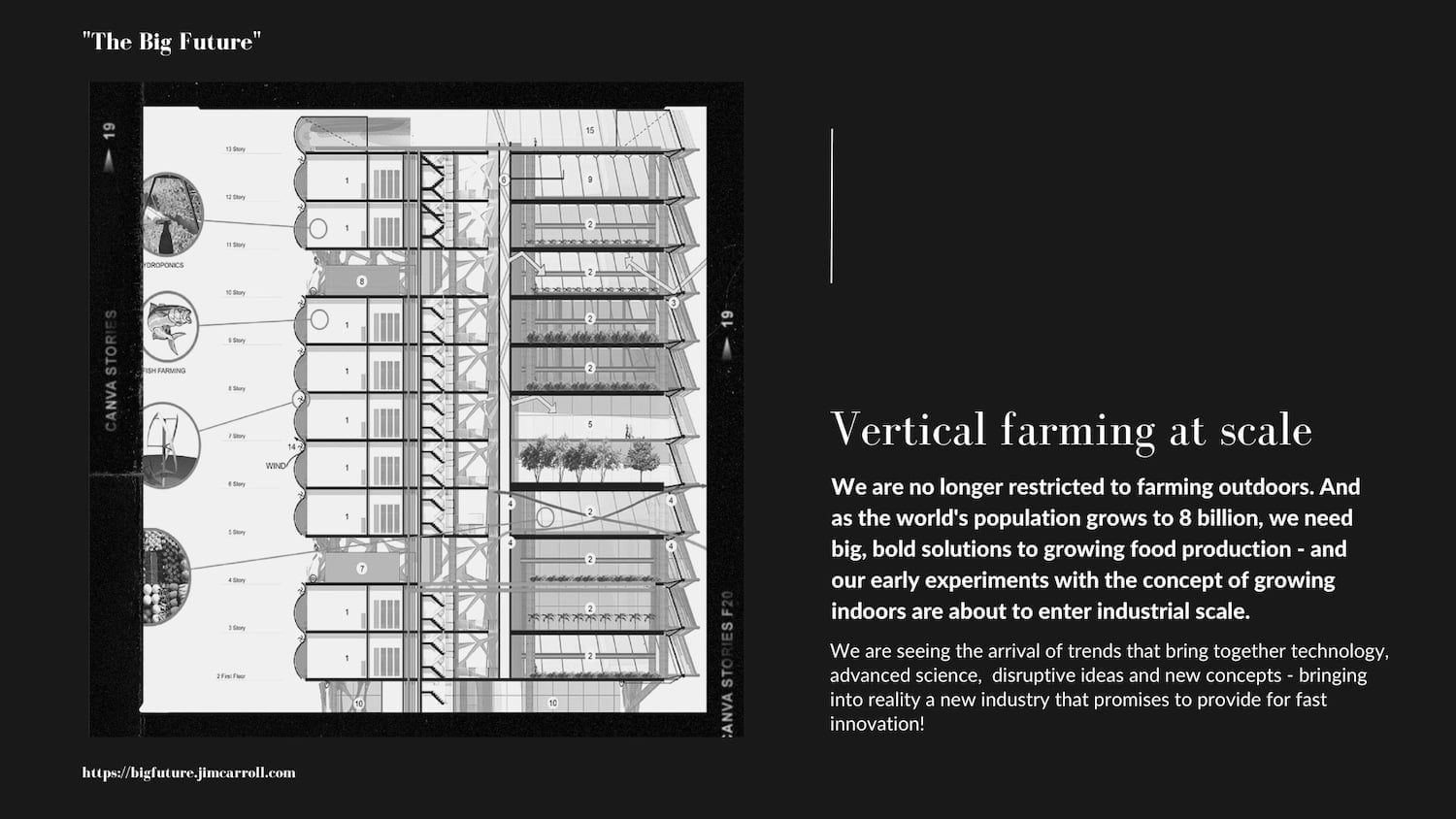
Vertical farming? It’s a fast-moving industry – and very, very new. Farming has been with us for centuries; greenhouses for a few hundred years, but vertical farming for less than ten years. Yet it provides for an absolutely seismic shift in our concept of agriculture and farming.
So let’s dig in!
A Compelling Argument
First off, what is it? Here’s a good, simple summary.
“Vertical farming refers to indoor farming in controlled environments, usually in the absence of soil and natural light, and involves well-established horticultural techniques.”
No sunlight, no soil – no worries as vertical farming looks stacked with promise
28 January 2023, The Guardian
It’s also referred to, often by government types, as “Controlled Environmental Agriculture.”
The interesting thing is that the idea was first proposed in 1910 by a fellow named Gilbert Ellis Bailey, a Professor of Geology of all things at the University of Southern California.
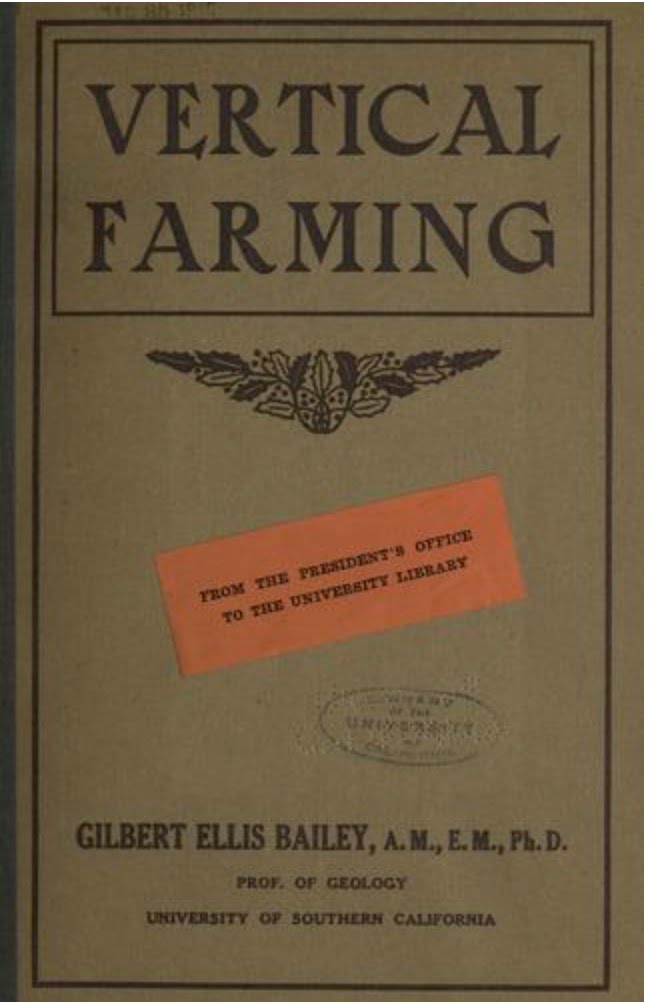
But after that, the concept really didn’t go anywhere until just over a decade ago:
American academic Dickson Despommier first floated the idea of vertical farming more than two decades ago, envisaging city skyscrapers filled with products to feed tens of thousands of urbanites.
Efforts to put vertical farming into practice began around 2010
No sunlight, no soil – no worries as vertical farming looks stacked with promise
28 January 2023, The Guardian
I became aware of the trend during this time while preparing for the many keynotes I do in the agricultural and farming sector – it kept on popping up in my research studies and trend-tracking systems. The result was that I first began speaking about it on stage shortly after that time, particularly in the context of the rapid emergence of new careers such as Vertical Farming Infrastructure Managers. Here’s a clip from 2013 where I’m talking about the trend.
Over the years, I’ve continued to cover the topic on stage, including this clip from my 19 Trends for 2019 series:
Today, you will see it being covered in the news in reports like this:
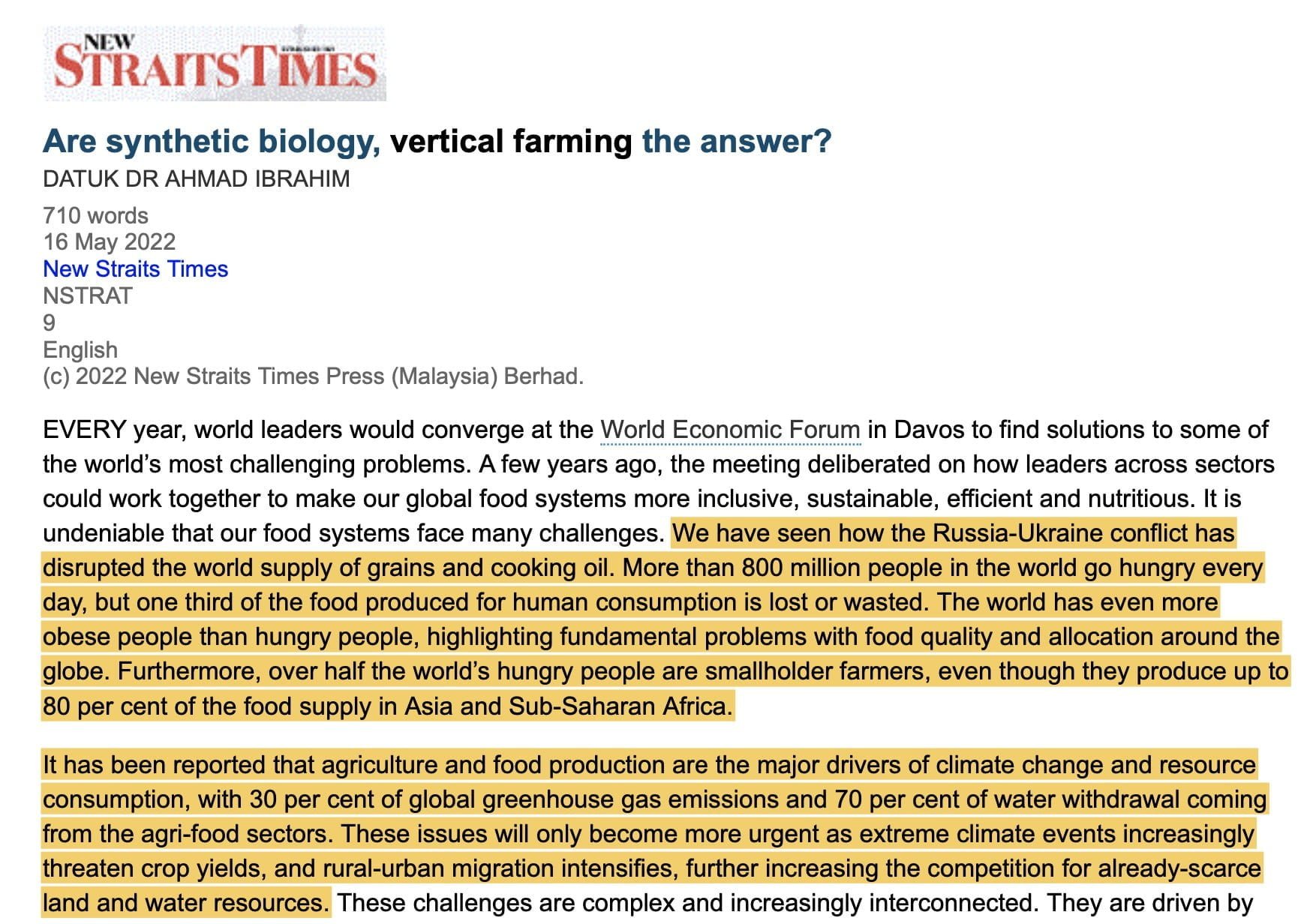
The types of vertical farming
Essentially, there are three types of vertical farming – hydroponics, aeroponics, and aquaponics.
Hydroponics is the one that people are most familiar with – water rich in nutrients is the primary growing medium with virtually no use of soil. Aeroponics follows the same concepts but the plants are sprayed with a nutrient-rich mist, using even less water. Aquaponics is, as the name suggests, very water-based, bringing fish into the hydroponic system to create a mutually beneficial environment for the plants and fish. All of these methods have been around us for years, but what is accelerating is innovation, largely driven by the benefits of technology and accelerating science.
And interestingly enough, much of the early research on vertical farming – particularly the first two types – had to do with the illegal growth of marijuana. And now in many countries, as legalization occurs (as in my home country of Canada), we are seeing the idea of ‘growing at scale.’ What we have learned there is now bringing to traditional agriculture.
What’s also driving the trend forward is a realization that we can’t keep doing what we’ve been doing.
The Global Food, Water, and Growth Crisis
Why is there such interest in the idea now? At the heart of it, there is a growing realization that vertical farming helps us to deal with some of the most significant challenges that society is faced with when it comes to food and agriculture.
- we expect the global population to grow to 9 to 10 billion by 2050, but the available arable land for farming is estimated to be but 1/2 of what it was in the 80s – as a result of the growing global climate emergency
- that suggests we need to produce 70% more food with far less land!
- in that context, conventional agriculture is truly a resource hog: it uses 80% of our freshwater, produces 24% of greenhouse gas emissions, and erodes and destroys soil with tilling and other methodologies. In addition, the pesticides and fertilizers that are used do cause long-term environmental damage.
- global warming is only going to make things worse. All you need to do is look at the growing battle over access to Colorado River water resources to come to the realization that some farmers, particularly in California and Arizona, will not be able to grow crops anymore – and more land will become infertile
The benefits of vertical farming? Almost too vast to mention!
- it reduces land use by 90 to 99% while vastly increasing productivity from each square meter of land – we can often get 3 to 10 times more crops from the same area. One German vertical farm company reports being able to grow 26 times more wheat in a vertical farm than found with open-field farming!
- in some facilities, a vertical farm “acre” can take up as little as 40sq m of ground space but can produce the same number of plants that would take 10,000sq m on a traditional farm!
- water can be reused and recycled over and over with little loss. Hydroponics uses 90% less water, and aeroponics uses 95% less than traditional farming systems. The water issue is huge considering the drought in the western US as well as other regions of the world. In addition, it provides a compelling reason to accelerate the opportunity throughout the Middle East – Saudi Arabia and the U.A.E. have bold vertical farming goals and some pretty significant projects for this very reason. This includes significant investment in accelerating desalinization technology.
- not only that, but as water moves through the vertical farming system, most of it is captured and re-used. Some say the only water that leaves a facility is found in the plants and vegetables that are shipped out once they are ready for market.
- virtually anywhere can be used for vertical farming – from the rooftops of buildings to abandoned warehouses, although we are seeing the construction of more and more vertical-farming-at-scale facilities
- year-round, 24-hour production is possible, going to the point that I often make on stage that “we are moving from a world where we only farm when the sun is up to continuous, nonstop 24-hour farming“
- environmental factors are well controlled, preventing crop loss due to drought, freeze, or frosts. Everything can be managed, from lights to water, temperature to humidity, irrigation systems to cameras to monitor growth (and utilize AI to monitor that growth)
- it significantly reduces the cost of bringing food from farmlands into urban areas – in my own case, I’ve got a pretty significant vertical farm, from one of the leading companies in Canada, just about a mile from my back door. The average food item travels some 1,500 miles before it reaches our dinner table, resulting in food loss, and massive carbon use in transportation. Consider this: nearly all of the leafy greens in the US come from California, Arizona, and Mexico – and so by the time it gets to market, it is already a few days old! Here’s a fact to think about: 90% of leafy greens grown in the U.S. are transported more than 3,000 miles to consumers on the East Coast.
- 70% of the world’s population will live in urban areas by 2050, up from 50% today – and so this transportation issue becomes a huge opportunity. Africa is urbanizing so fast that by 2030
it will cease to be a rural continent – and is already experienced with the idea. Already there are 800 million ‘city farmers’ according to UN statistics, including
25% of the population of Burkina Faso, 35% of Cameroon, 63% of Kenya, and 68% of Tanzania. 90% of the fresh vegetables in Accra, Ghana come from farming within the city – and so as the industry matures, the opportunities throughout the continent are massive! - we can see a reduction in the number of toxic pests since almost all of the production occurs in a large sealed environment indoors. This leads to a reduction in the use of harmful pesticides and other control mechanisms
- it eliminates or diverts significant capital cost investments such as tractors equipment – although as we start to build large-scale facilities, we could say that investment is merely being diverted to a different purpose
- speed to market! It’s common for full-size basil plants to grow in but three weeks, and micro-herbs in just one week. A full wheat crop can take six to 10 months to grow outdoors but only 2 to 3 months on a vertical farm. In winter climates, the production increase is huge – in Michigan, we can harvest lettuce 17 times a year compared to once or twice per season in outdoor farms.
- technology is coming into the industry, with AI being used to monitor and manage growing conditions, and robotics are being used to manage all aspects of operation, including watering, monitoring, and such aspects as automatic pollination
Bottom line? All of these trends provide a compelling argument for moving forward!
One advantage of indoor farming is that the conditions can be optimized to shorten the time to harvest. “For leafy greens, we’re getting a crop … at least every four weeks or thereabouts,” Millett says. Spencer cites a similar length at Stacked Farm, with a growth cycle taking between 14 and 30 days for leafy greens.
“For traditional farming, depending on the region and if the climate is [good], you get anywhere from five to six harvests a year,” he says. “In indoor farming, we’re now getting roughly 17 harvests … out of that same period.”
No sunlight, no soil – no worries as vertical farming looks stacked with promise
28 January 2023, The Guardian
The biggest problem? Energy! It takes a lot of it to keep those lights running 24 hours a day. But the marriage of vertical farming to accelerating solar technology, microgrids, and battery storage technology which I covered in trend #1 in this series promises some innovative opportunities in that regard going into the future.
Fast Innovation
There are a lot of wonderful stories as to what various companies are up to :
- Plenty Inc, a US indoor agricultural company, announced what it says will be the world’s largest vertical framing research center in Wyoming. The company already has over 100 patents for new innovations involving new crop-growing systems, new tomato plant varieties, and methodologies to detect plant stress. That facility comes a year after they build a $300 million, 485,000-square-foot facility in Richmond, Virginia
- In Quebec, Canada, a new startup Winter Farm, plans on producing up to one million kilograms of strawberries a year – that’s almost 1% of what is brought in from California and Mexico each year. Farming for many family generations, the founders are eager to explore this new world of agriculture – with a bigger goal of replacing 10% of those imports. It’s a compelling argument – they can grow 97 strawberry plants per square meter, 10 times the density of a traditional greenhouse.
- We’re even using it for tree seedlings – Forestry and Land Systems Scotland is growing seedlings in about 90 days indoors, compared to 18 months outdoors, six times after. Much of the operation is robotic, with specialized technology delivering trays of seedlings to the well-lit shelving areas after preparation. The organization estimates that it builds its own growing tower, it could produce in one facility 60% of its overall annual requirements
- In Singapore, 90% of the food comes from outside the country – from up to 190 different countries! But they have established a goal to produce 30% of its nutritional needs by 2030, much of that from vertical farms.
Investment Money
What’s moving so fast is also the realization that this is an industry with explosive potential. Much of the last decade has been spent on experimentation and exploration – but the concept has proven quite viable, so it is moving to the next phase.
And money is flooding in! It’s estimated that in 2019, there were just a few hundred million dollars going into the sector – it’s now in the billions. Globally, the industry is expected to be worth about $6 billion this year, up from $3 billion the year before. Some expect it to reach $24 billion by the end of the decade.
The company that is just south of my home, GoodLeaf Farms, has raised US$110 million in a recent funding round, with much of the funding coming from the global potato size McCain Foods. That’s typical of what is occurring in the sector. But as with any nascent industry, there are early successes and challenging failures; optimism about what is possible, and skepticism about the results so far. There is no shortage of stories in the media today of the financial struggles of some of the early pioneers who are attempting to pursue the trend at scale – but that can be expected with any new trend that has potential.
In my case, I feel fairly confident saying that in ten years, this is in the industry we will look back at and say, “Whoah!”
Vertical farming “Not at Scale”
The fun aspect of this trend is that around the world, much of the research and development is occurring, as it does with many trends, in the global hobby community. And I’ve watched this happen rather close to home.
My 29-year-old son is an inveterate technology tinkerer – a drone pilot during the day, he pursues multiple technology and other projects at night. During the global pandemic – needing something to do with his spare time, he began exploring the world of ‘indoor farming.’ It was easy enough to do – the Internet is full of tips and guidance, video, and how-to guides. For example, he began to watch the many videos from “Hoocho,” a fellow located in Australia. There’s obviously interest in the topic with most videos having more than 50,000 views.
And so while writing this post, I thought it might be worthwhile to explore his current setup as a way of describing the science and technology behind vertical farming. Here’s an overview of his setup as of this moment in time.
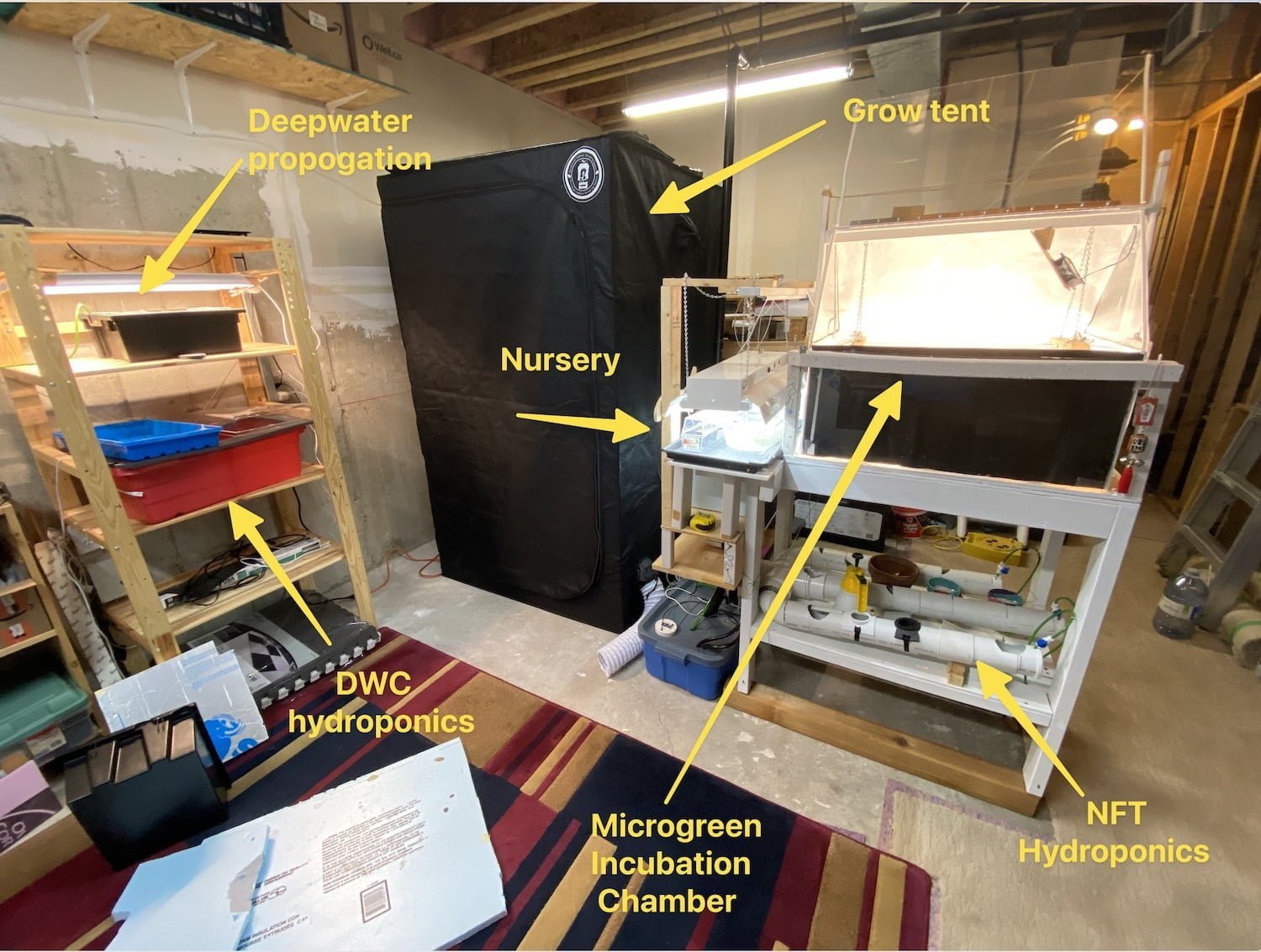
Currently, he is regularly preparing batches of ‘microgreens’ for use in salads and sandwiches, and other concoctions; they are beneficial from a health perspective e with a lot of healthy nutrients, are fast to grow, and as he says, ‘taste good.’ I’ve tried them just now, and I agree. He’s also growing lettuce, cucumbers, tomatoes, basil, and eggplant at this moment in time.
Here’s another view of the setup that he he has in place.
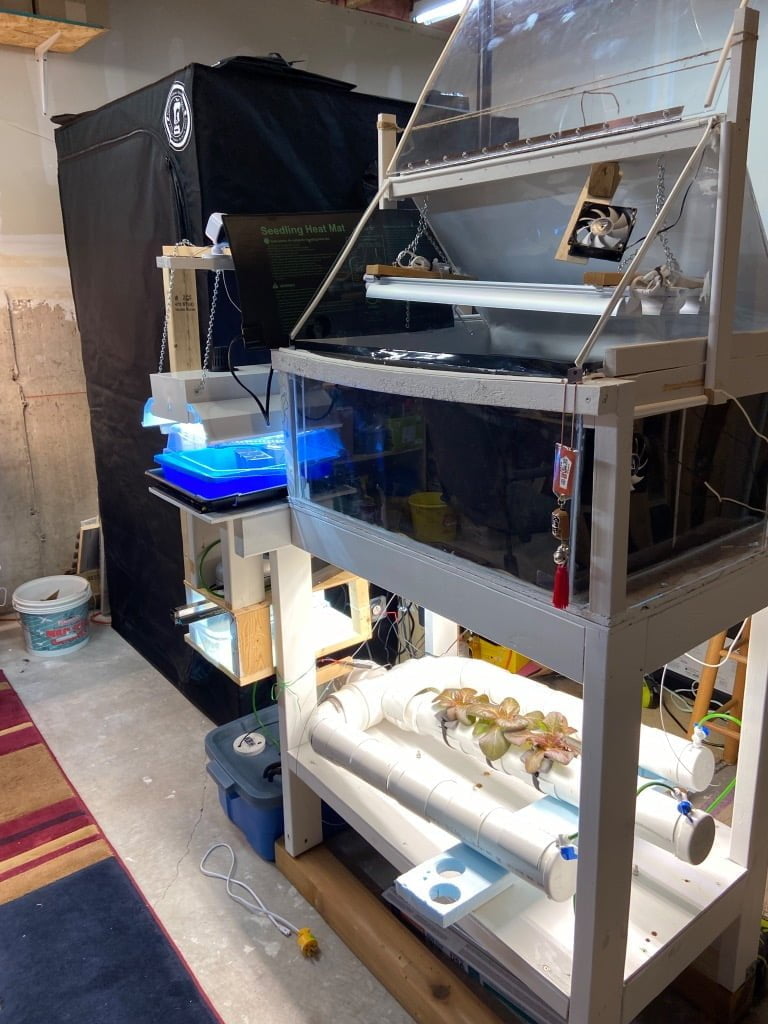
What’s the process for microgreens? First, the nursery – he didn’t have a picture available – where all the seeds are started in a hydroponic growth media, which is mostly rockwool, and cotton balls (which is the same material used in many industrial vertical farming facilities.) When the plants are ready they are transferred to the ‘deep water propagation tank.’
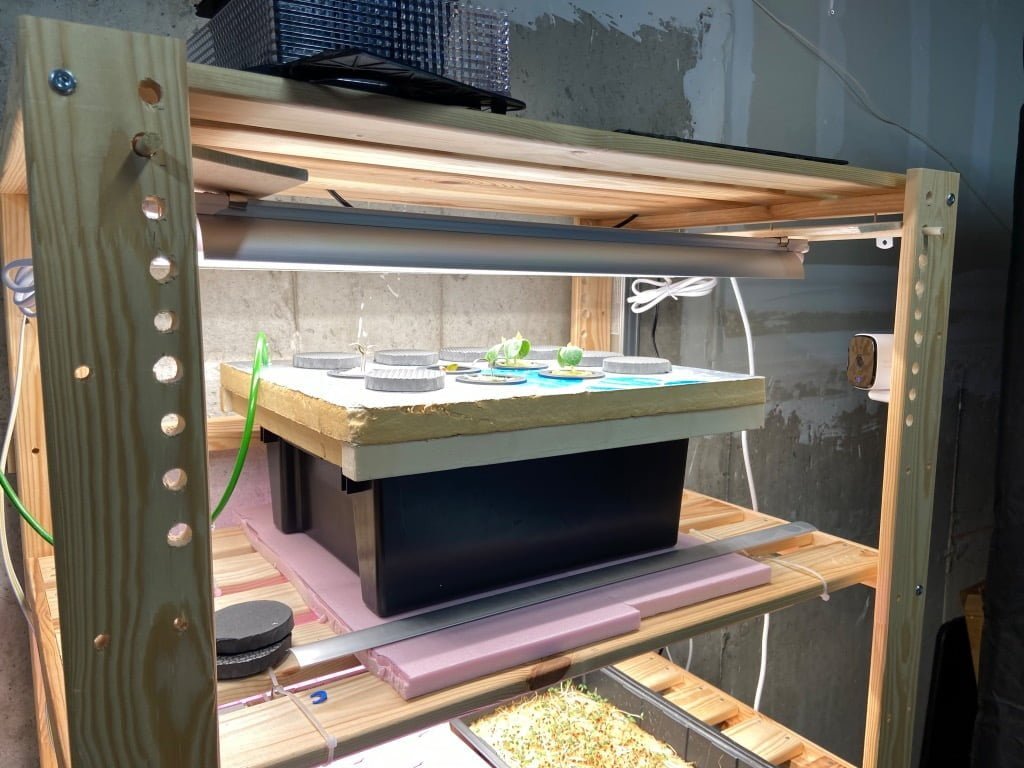
When the plants are transferred here, they stay for about a week and a half. It’s filled with reverse osmosis water and a cloning nutrient mix; this helps them from being seedlings to being close to maturity, ready for full-strength nutrients. He sources the reverse osmosis water system from Facebook Marketplace for $40 – it’s a $1,200 system that they might have been using for drinking water.
Once the plants are ready, they go into the NFT Hydroponics system – it’s a tube that has a thin film of nutrient-rich water that flows over the plants, constantly bathing them in a nutrient. They are here until they are ready to pick – so this is how he grows lettuce. He built this system using 3″ sewer pipes, among other things. The pipes flow into a water reservoir that has a temperature sensor, with a pump that flows the water into the tubes, and an airstone that aerates the water.
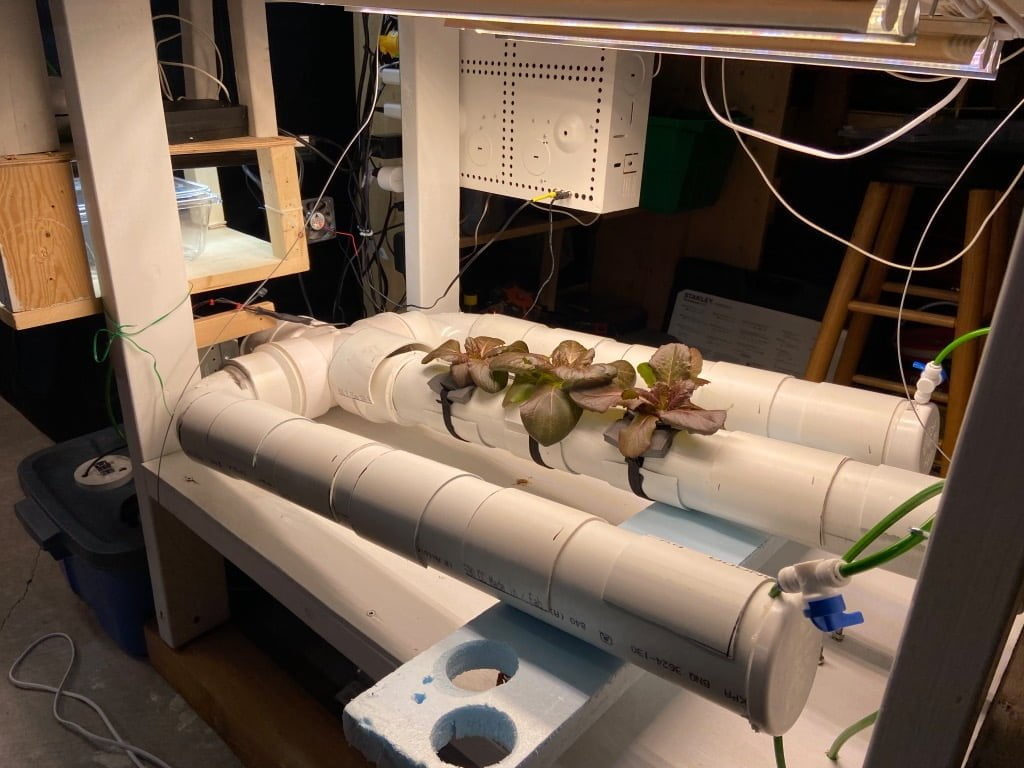
The result of this is the various vegetables mentioned above – he gets lettuce to harvest in about 30 days.
That’s but one part of his system; the microgreens are grown inside a separate system, a fully enclosed plexiglass greenhouse system that has LED grow lights. When he is growing microgreens they start out on a hemp mat that is soaked, and placed on top of the seeds. Once they have sprouted through the hemp mat, they are then given water. These are the micro-greens in the early seedling stage on the mat.
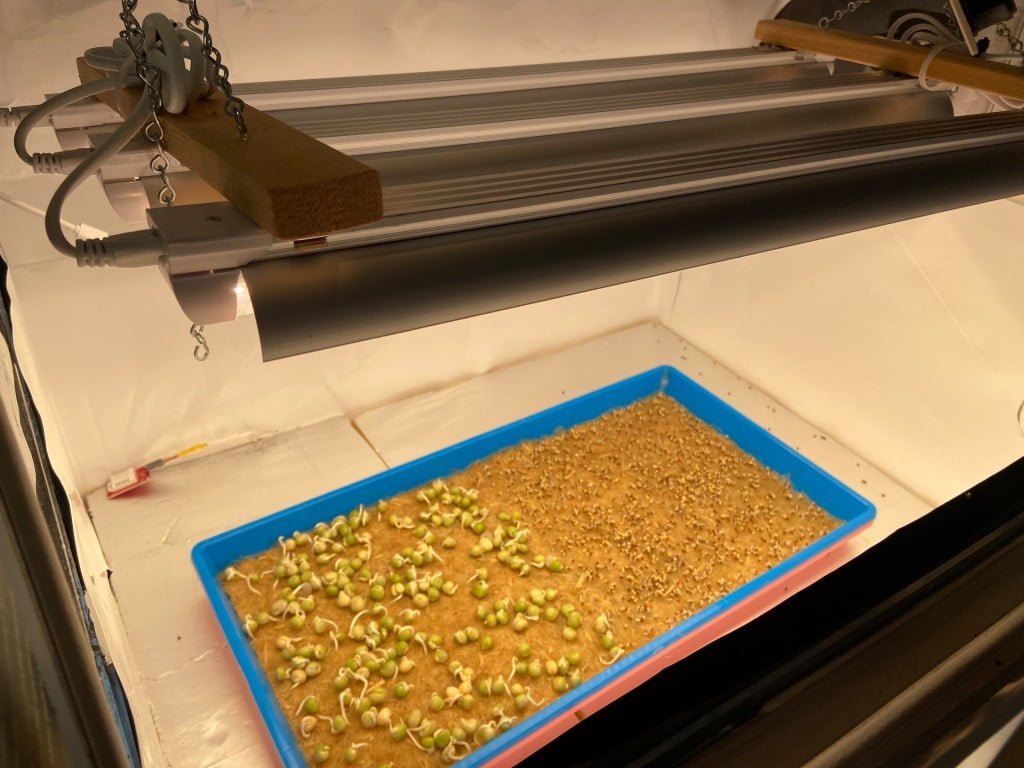
He’s monitoring all of this with a sophisticated set of software that he has programmed onto a Linux system based on software called Home Assistant. Through this, he can control all the lights and fans, with the goal of being able to control the nutrient and pH dosing pumps that are a part of the system, through an interface that looks like this:
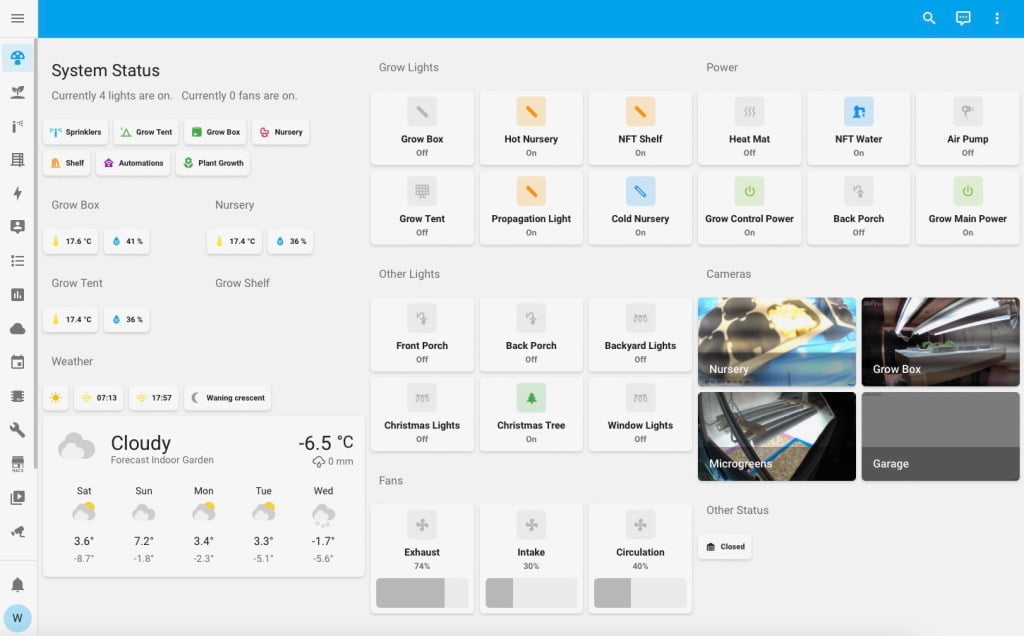
He’s programmed into this additional details concerning tray layout, planting dates and maturity days, and time estimates for days to harvest, in order to keep track of what he is up to.
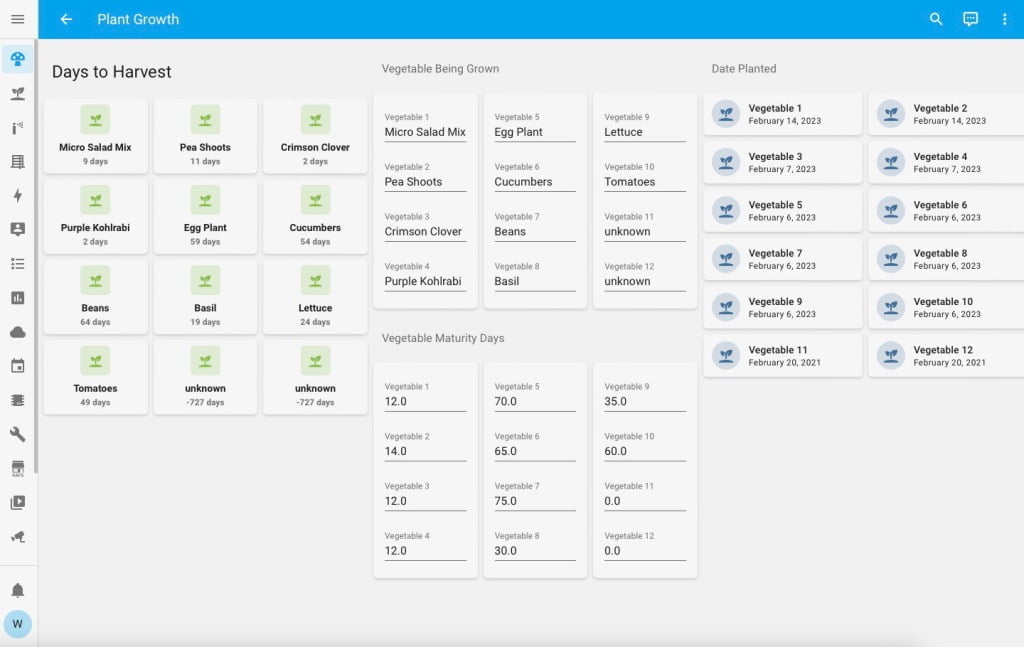
He’s built (and continues to build) a lot of the custom hardware used in the setup, including several PCB boards that are used in the setup above. This particular unit is used for controlling the fans in the greenhouse, monitoring temperature in the basement and greenhouse, and eventually will be used to monitor pH levels and \total dissolved solids in the water reservoirs. (It’s important to track this to make sure the plants are ingesting enough nutrients, and to monitor the actual nutrient value in the water.)
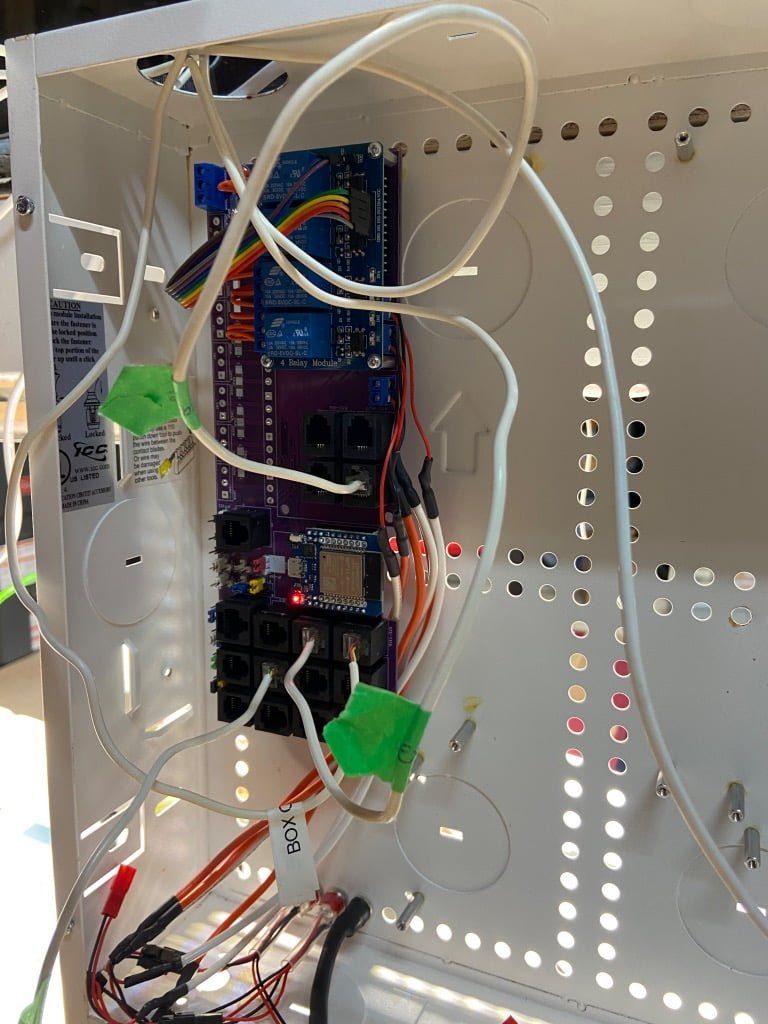
There’s also this unit which is a part of his outdoor garden (similarly wired and intelligent) with a fully automated outdoor irrigation system. This is used for monitoring soil moisture in the outdoor garden; he’s working to integrate this type of technology into his internal system.
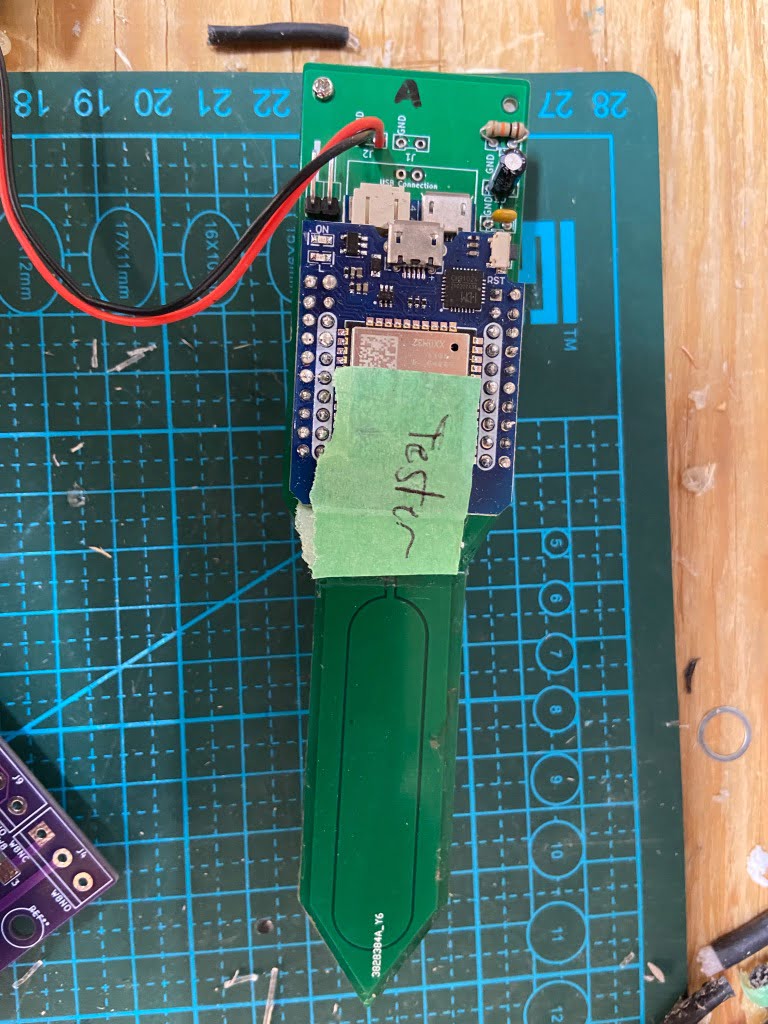
That, in essence, is the idea of a vertical farm! Here’s my son arriving at our chalet with a small batch of microgreens which we used in our Mexican salad and tacos on his arrival!

Now take this concept, make it bigger, and stick it into a warehouse!
Scaling to Industrial Scale
Take the type of thing my son is doing and scale it up. That’s what’s beginning to happen with ‘vertical farming at scale.’
Take this project in South Africa:
Using CAN-Agri’s globally patented technology, the Pretoria facility has the capacity to grow over 384 000 plants at its 3 200 m2 growing area. This farming method uses 95% less water, 85% less fertiliser and no pesticides.
Seedlings are grown in seed trays using bio-degradable baskets for three weeks in the nursery greenhouse before they are transplanted into grow tubes in the main greenhouse which has 24 rows spanning 6 meters high. Each row has 200 “growing stacks” which grows 80 plants each.
“The growing stacks are strategically spaced in rows to allow for maximum sunlight. Purified, oxygenated, nutrient-rich water is fed through the top of the grow tubes, it then gravitates down through the tubes flowing over the roots of the plants and is recycled in a continuous closed-loop system,” says Van der Merwe.
The growing stacks are also used to control the climate in the greenhouse. The nutrient-rich water is either cooled or heated, and the grow stacks perform the function of a giant radiator by maintaining an optimum climate.
Sold on in-store vertical farming
29 March 2022, People’s Post
What is happening today is that companies are taking these ideas and turning them into large-scale facilities – and also in many cases, developing modular technology systems that allow others to build their own vertical farms.
Take Agrify, which is bringing to market what it calls, for lack of a better phrase, VFU’s – or, “Vertical Farming Units” – which are units that are entirely self-contained and stackable. Each unit contains the necessary monitoring and management technology, lighting, and watering systems.
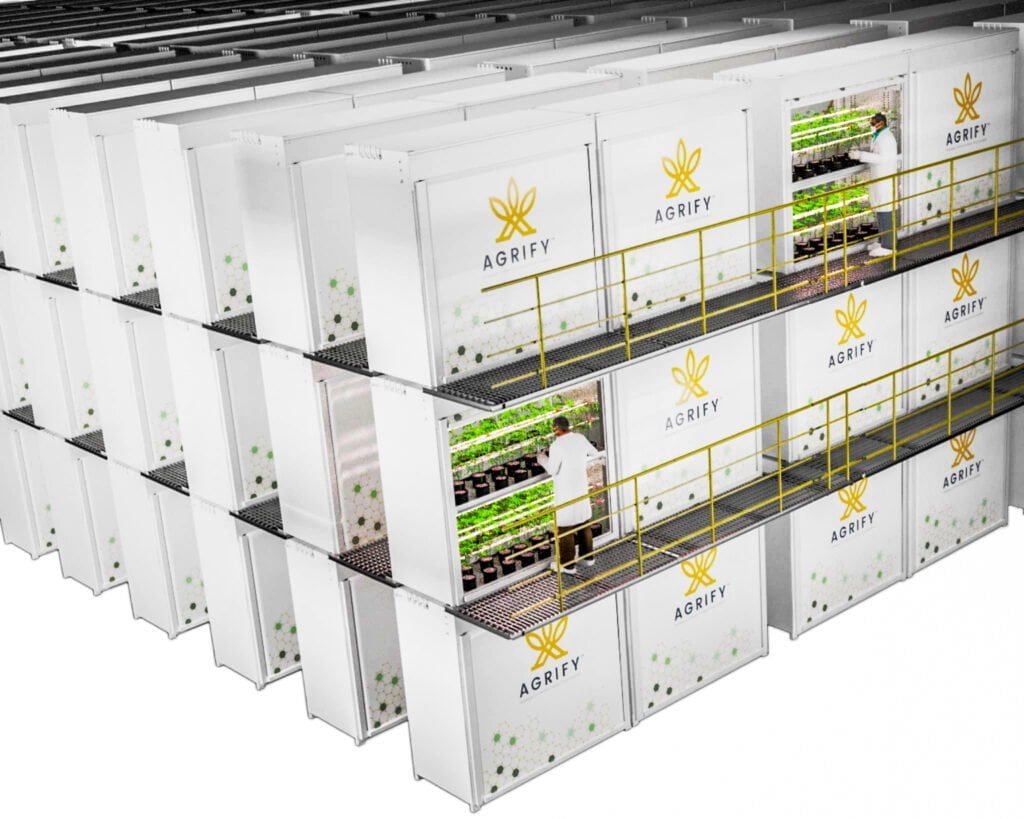

Some of these companies are also placing these in grocery stores as a way of helping people understand what the idea is all about.
Vertical farming? Put it all together, and you get something like this:
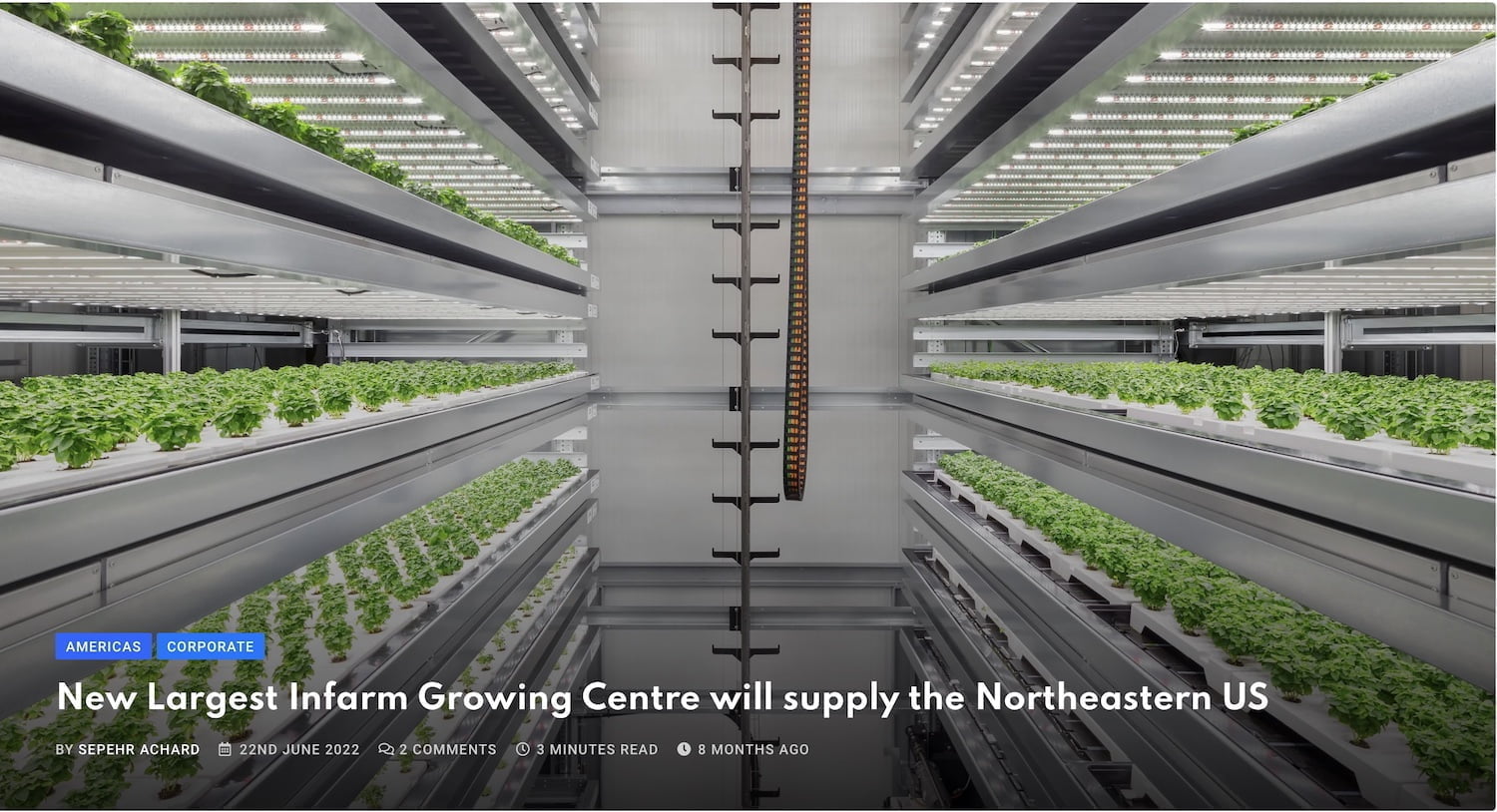
As someone who tracks trends and the future, I believe that this trend is so compelling, and moving so fast, solving big problems, that it is one of the most significant trends that will unfold at speed over the next ten to twenty years.




GET IN TOUCH
Jim's Facebook page
You'll find Jim's latest videos on Youtube
Mastodon. What's on Jim's mind? Check his feed!
LinkedIn - reach out to Jim for a professional connection!
Flickr! Get inspired! A massive archive of all of Jim's daily inspirational quotes!
Instagram - the home for Jim's motivational mind!